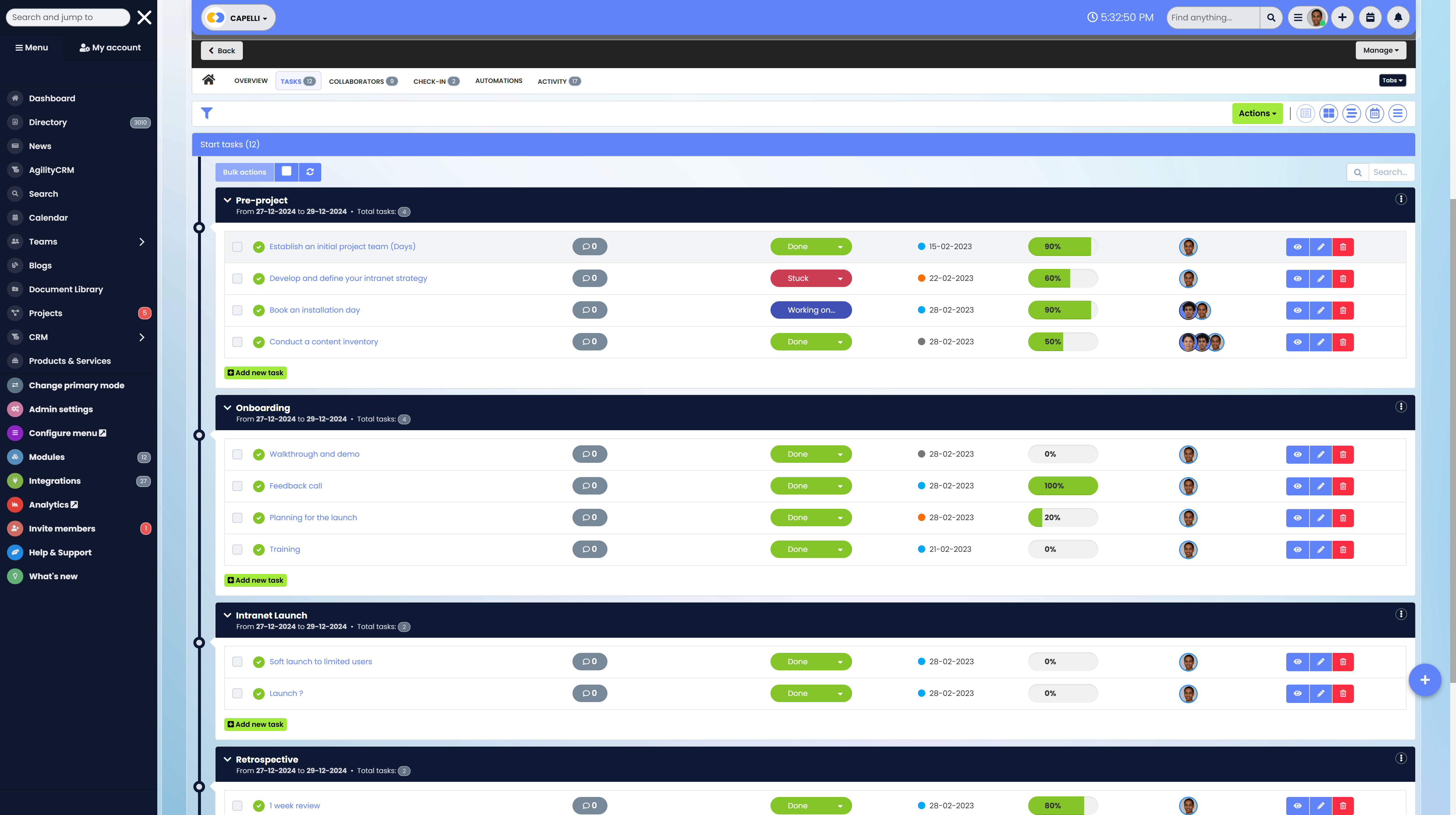Insight Blog
Agility’s perspectives on transforming the employee's experience throughout remote transformation using connected enterprise tools.
10 minutes reading time
(1981 words)
How to Do Software Development Capacity Planning and the Importance of Capacity Planning
Learn how to do software development capacity planning and why it's vital for project success, resource management, and agile team efficiency.
Are you allocating your team's time and resources effectively, or just hoping for the best?
In the fast-paced world of tech, poor planning can delay projects, frustrate teams, and burn through budgets.Over 55% of software projects fail due to inadequate resource planning—a clear sign of how critical capacity planning is to success.
Software development capacity planning isn't just a behind-the-scenes process—it's the strategic backbone of any high-performing dev team.
Software development capacity planning isn't just a behind-the-scenes process—it's the strategic backbone of any high-performing dev team.
Whether managing sprints, estimating workloads, or preparing for scale, understanding the importance of capacity planning helps ensure the right people are working on the right tasks at the right time.
In this guide, we'll break down how to plan capacity for software development effectively and why it's essential for hitting deadlines, maintaining team productivity, and delivering high-quality software on time.
Let's dive into the what, why, and how of getting it right.
In this guide, we'll break down how to plan capacity for software development effectively and why it's essential for hitting deadlines, maintaining team productivity, and delivering high-quality software on time.
Let's dive into the what, why, and how of getting it right.
Read this article: : Top 6 AI-Powered Project Management Tools To Use In 2023
What is Software Development Capacity Planning?
At its core, software development capacity planning is the strategic process of ensuring your team has the right amount of resources available to handle current demands and future workload increases.
It's about finding the balance between what your team can handle today and what they'll need to handle tomorrow.
During this planning process, development teams aim to answer four critical questions:
- What is our current available capacity across projects or services?
- How much buffer capacity do we need to stay flexible and reliable?
- How much additional workload is expected—based on user growth, new features, or seasonal demand?
- What resources must we add now to meet future demands without overwhelming the team?
These answers form the foundation for forecasting future needs and guiding resource allocation decisions.
Unlike reactive task management, Capacity planning software empowers development teams to stay agile while consistently delivering high-quality results. By assessing current team bandwidth, forecasting future workload, and incorporating buffer zones for unexpected changes, managers can build development roadmaps that are both realistic and resilient.
This proactive approach enables organizations to scale efficiently, respond to shifting priorities, and eliminate potential bottlenecks before they occur.
Capacity Planning Example:
3 Common Capacity Planning Strategies in Software Development
Capacity planning is not a one-size-fits-all approach—it must be tailored to your team's resources and projected workload.
Here are three of the most widely adopted capacity planning strategies:
- Lead Strategy - Lead capacity planning focuses on staying ahead of demand. In this proactive approach, additional resources or infrastructure are added before demand actually increases. This is especially useful for businesses expecting rapid growth or seasonal spikes in activity. It ensures your development team is never caught off guard but can sometimes lead to unused capacity if growth doesn't occur as forecasted.
- Lag Strategy - Lag capacity planning takes a more conservative route. Resources are added only after a noticeable rise in demand. This approach helps reduce the risk of overinvestment and is ideal for organizations prioritizing cost control. However, the downside is the potential for delayed responses to demand spikes, which can lead to short-term delivery bottlenecks.
- Match (or Tracking) Strategy - Match strategy planning strikes a balance between lead and lag. Capacity is added incrementally, in response to actual trends and forecasts. This approach maintains flexibility while minimizing both under- and over-utilization. It's a great fit for teams operating in dynamic environments where demand changes gradually over time.
Who is Responsible for Capacity Planning in Software Development?
Software development capacity planning is a cross-functional process involving several key roles working together to ensure project success. Typically, this includes:
- Project Managers – who align resources with timelines and deliverables
- Product Owners – who prioritize features and ensure customer needs are met
- Developers – who estimate effort and report on progress
- DevOps Engineers & IT Operations – who monitor infrastructure capacity and scalability
- Data Analysts – who provide insights based on usage trends and forecasts
For example, in large-scale environments like New Relic, where over 50 engineering teams contribute to the platform, each team is responsible for its own capacity planning—making it a shared and essential responsibility across the entire organization.
How Capacity Planning Tools Are a Strategic Asset in Improving Software Development
So, you think about important capacity planning tools in software development and are not sure how they will help?
Capacity planning tools have become a strategic asset for modern software development teams aiming to balance resources, timelines, and workload with precision. These tools offer more than just visibility—they empower teams to make proactive decisions based on real-time data, historical performance, and future projections.
By using capacity planning software, development teams can accurately assess their current workload capacity, identify bottlenecks, and plan ahead for upcoming projects or scaling demands. This level of forecasting allows managers to allocate tasks more effectively, avoid overloading individual developers, and maintain consistent delivery cycles—all without compromising quality.
One of the most significant advantages of these tools is their ability to align development goals with actual team capabilities. Instead of relying on guesswork or reactive management, project leads can use hard data to forecast sprint velocity, evaluate resource gaps, and decide when to onboard new team members or reassign tasks. This not only improves software development efficiency but also boosts morale by setting realistic expectations.
It is also worth mentioning that capacity planning tools enhance collaboration between developers, project managers, product owners, and IT operations. Everyone gains a clear understanding of priorities, timelines, and resource availability—leading to better alignment and fewer delays.
In fast-paced environments where agility and time-to-market are critical, these tools transform planning from a reactive function into a competitive advantage.
When applied strategically, capacity planning software is not just a support tool—it becomes an integral part of a sustainable, scalable, and successful software development lifecycle.
Why You Should Use Capacity Planning in Software Development
Effective capacity planning in software development is essential for maintaining productivity, reducing risks, and ensuring timely project delivery.
It helps teams stay ahead of workload surges and avoid bottlenecks that can derail timelines.
In today's fast-paced, data-driven environments, organizations are turning to capacity planning tools to manage uncertainty and scale with confidence.
Here's why:
- Adapting to Changing Priorities - Agile environments demand flexibility. Capacity planning software enables real-time resource reallocation to meet shifting deadlines and priorities without disrupting team momentum.
- Supporting Hybrid and Remote Work - Distributed teams are now the norm. With the right tools, managers gain clear visibility into team availability, workloads, and collaboration efficiency—no matter where employees are located.
- Addressing Resource and Skill Gaps - Talent shortages and budget constraints are ongoing challenges. Capacity planning tools help identify underutilized resources, prevent over-allocation, and ensure the right people are assigned to the right tasks.
- Improving Forecasting with Real-Time Data - Modern capacity tools integrate with project management platforms and time-tracking systems to provide live data, improving forecast accuracy and supporting smarter decision-making.
- Aligning Tasks with Strategic Goals - By automating workflows and offering advanced planning features, these tools help teams connect daily activities to broader project milestones and business objectives.
Using capacity planning tools in your software development workflow empowers teams to operate efficiently, adapt rapidly, and stay aligned with both tactical needs and long-term goals.
Capacity Planning Software
Capacity planning software tools refers to the use of digital platforms to forecast, allocate, and manage resources effectively throughout the software development lifecycle.
These tools help project managers and engineering leads assess team workloads, track availability, and identify resource gaps before they become bottlenecks. Unlike manual planning, capacity planning software leverages real-time data, historical trends, and predictive analytics to optimize task assignments and timelines.
This ensures teams aren't overcommitted, deadlines remain realistic, and performance stays consistent.
In agile and fast-paced development environments, these tools are essential for aligning team capabilities with project demands, improving productivity, and reducing delays.
Now let's explore some of the top tools used for capacity planning in software development.
| Tool | Cost (Starting Price) | Best Features |
| AgilityPortal | Free trial / Custom pricing | Integrated intranet + task management, real-time team capacity, remote team support |
| Float | $6 per user/month | Visual resource planning, forecasting, real-time availability tracking |
| ClickUp | Free / $7 per user/month | Custom dashboards, workload management, integrations with GitHub, Slack, etc. |
| Toggl Plan | $9 per user/month | Drag-and-drop scheduling, timeline views, workload visibility |
| Forecast.app | $29 per user/month | AI-powered predictions, budget tracking, project timelines |
Read this article: : Top 6 AI-Powered Project Management Tools To Use In 2023
The Future of Capacity Planning with AgilityPortal
As digital transformation accelerates, the future of capacity planning lies in smarter, more predictive solutions driven by automation, real-time data, and artificial intelligence.
These technologies will redefine how businesses assess workloads, anticipate demand spikes, and align resources with project goals.
Machine learning will play a pivotal role in improving the accuracy of forecasting, allowing teams to plan proactively instead of reactively. With AI-enhanced insights, businesses can detect trends early and adjust capacity with confidence—ensuring that no opportunity is missed and no team is overburdened.
This evolution will also support multi-team and cross-departmental coordination, enabling enterprises to manage capacity at scale across various units or locations.
That's where AgilityPortal stands out.
With AgilityPortal's integrated capacity planning tools, organizations gain the flexibility to allocate resources efficiently, adapt to shifting priorities, and ensure optimal productivity at all times. Whether you're running a small agile team or managing enterprise-wide projects, AgilityPortal empowers you to build a more resilient, scalable, and future-ready workforce.
Start your free trial today and experience how AgilityPortal can help your team stay ahead of capacity challenges—without compromise.
Conclusion
Capacity planning software lends powerful features to execute projects, and professionals can maximize the overall output with clear objectives.
This project management solution can prevent resource shortages and mitigate negative effects during crises while strengthening the competitive edge of the enterprise.
In this regard, a project management suite becomes an essential component in sustaining growth and building organizational resilience in evolving business demands.
Epicflow is a comprehensive solution for project management needs, which provides the latest AI features to enhance their performance in modern industries from defense to healthcare.
Frequently Asked Questions
What is capacity planning in software?
Capacity planning in software refers to the process of evaluating current development resources and forecasting future workload to ensure teams can deliver projects efficiently.
Capacity planning software helps teams manage time, skills, and availability, reducing bottlenecks and improving delivery outcomes.
What is the best tool for capacity planning?
The best tool for capacity planning depends on your team's size and project needs.
Tools like AgilityPortal, Float, and ClickUp are popular for their intuitive interfaces, resource forecasting, and integration capabilities.
Capacity planning software streamlines task distribution, timeline visibility, and real-time performance monitoring.
Does Jira do capacity planning?
Yes, Jira can support capacity planning through plugins like Advanced Roadmaps or third-party integrations.
While Jira's native features offer sprint planning and workload tracking, dedicated capacity planning software provides more robust forecasting, cross-team visibility, and reporting functionalities.
How is capacity planning done in SAP?
Capacity planning in SAP is typically performed using modules like SAP PP (Production Planning) or SAP PPM (Project Portfolio Management).
These tools offer comprehensive dashboards to monitor project timelines, resource availability, and workloads.
For more agile teams, integrating SAP with modern capacity planning software can offer better flexibility and automation.
Categories
Blog
(2590)
Business Management
(318)
Employee Engagement
(204)
Digital Transformation
(172)
Intranets
(119)
Growth
(118)
Remote Work
(61)
Sales
(48)
Collaboration
(37)
Culture
(29)
Project management
(29)
Customer Experience
(26)
Knowledge Management
(21)
Leadership
(20)
Comparisons
(5)
Ready to learn more? 👍
One platform to optimize, manage and track all of your teams. Your new digital workplace is a click away. 🚀
Free for 14 days, no credit card required.














